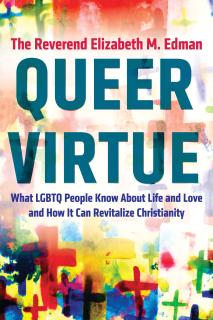Advertisement
Many queer people have been burned by Christian proclamation that leans too far toward rigid moralism. Many people of faith have grown weary of tepid Christian proclamations that, in the name of inclusion, fail to hold anyone to account. One side is soul crushing; the other is boring. How do we find our way back to the electric predawn, earth-altering moment in that garden where Mary Magdalene finds an empty tomb?
What always guides me back is an appreciation for the inherent liminality of the Christian tradition. I never cease to wonder at the frequency with which my queer identity and experience pop into view as I am studying scripture, pondering a sermon, or engaging someone in a pastoral conversation. I have long had to restrain the impulse to bring queer insight to bear explicitly. If I did so every time it occurs to me, that’s almost all I’d talk about.
Attention to the queerness of the Christian tradition has the potential to shed light on the part that progressives tend not to proclaim well: the content, the theological heft. Queerness can do this with particular potency for two reasons: First, because queer identity is itself the topic of some of the most energetic conversation between theology and ethics today, both within faith traditions and in secular society. Second, because LGBTQ people already speak the ethical language that is so familiar to this wing of the faith tradition. Which is to say, queerness can also be understood as a kind of path.
As with the Christian path, walking the path of queerness with honesty and some measure of integrity makes possible a kind of virtue. The path of queer virtue looks something like this:
One discerns an identity;
One risks telling oneself and others about that identity;
One engages with others, touches others, to explore that identity;
One confronts and is confronted by scandal;
One lives out one’s identity with and through community, looking to the margins to see who is not yet included.
Queer experience cannot be systematized. There is something about the image of a path that illuminates the relationship between these various experiences that LGBTQ people encounter, but that image is defiantly not rigid; there is nothing “step-by-step” about it. In fact, it is the nature of queerness to resist being neatly ordered. That resistance to ordering is one of the particular gifts of my people, and it is also one of the qualities that most puts us in touch with the divine (which, you may have noticed, also resists order). So don’t even begin to imagine a neat, well-trimmed walkway. If queerness is indeed a path, it is wild and chaotic, overgrown, twisting and turning back on itself, at times plunging into deep pools of unknown liquid, then emerging suddenly onto dry ground. On this path, the future is often so murky that you can’t see your hand in front of your face. Then suddenly you turn a corner, and a breathtaking vista opens before you.
Nothing on this path is once and done. The demands of this path—the obstacles and opportunities—interact with one another. They may take place in any order, and are likely to be repeated, exacting more precise demands all the time. A queer person lives them over and over again. None of us walks the path perfectly, and some queer folk are not able or flat out refuse to walk parts of it at all. But it constantly amazes me how dedicated my community is to this path, on the whole, and how hard we work both to stay on it and to make it accessible, possible, for others.
To the extent that queer experience can be conceived as a path, it bears a remarkable resemblance to the path of Christian virtue. And this is also clear: what I know about Christian virtue, about Christianity as a path, I have learned primarily from walking this queer path every day of my life.
This essay is excerpted with permission from Queer Virtue: What LGBTQ People Know About Life and Love and How It Can Revitalize Christianity, © Elizabeth M Edman (Beacon Press, 2016).

Queer Virtue: What LGBTQ People Know About Life and Love and How It Can Revitalize Christianity, by Elizabeth M. Edman (Beacon Press, 2016)
